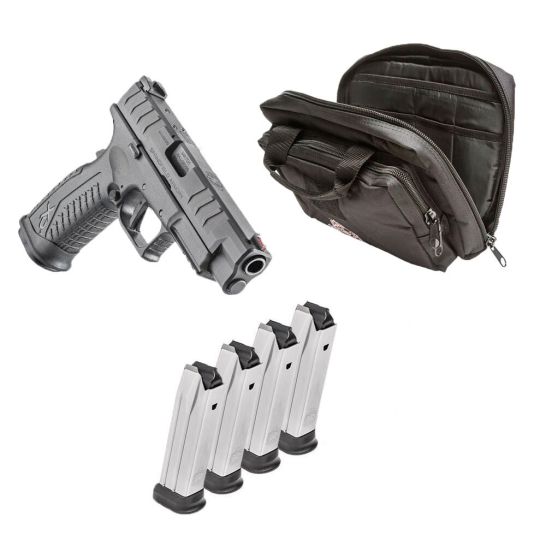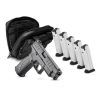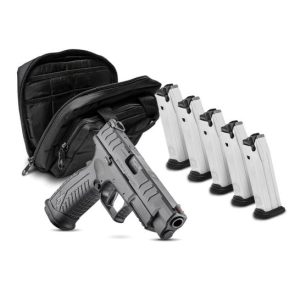Springfield Armory XDM Elite 10mm OSP 16rd 4.5" Gear Up – XDME94510BHCOSPGU22 For Sale
$549.99
The Springfield Armory XDM Elite 10mm OSP 16rd 4.5″ Gear Up is a powerful, precise, and versatile pistol from the Elite series, known for its sophisticated innovations. Chambered in 10mm, it features a high 16-round capacity and is designed with a Match Enhanced Trigger Assembly (META™) for superior shooting control. The pistol’s versatility is enhanced by its factory-milled slide that supports various optics for quicker target acquisition, while the extended and flared magwell ensures efficient reloads without compromising its compact form. Its user-friendly design is further complemented by enhanced slide serrations and an ambidextrous slide stop, making it ideal for shooters seeking a reliable and adaptable firearm.
Did Springfield discontinue the XD-M 10mm?
As of my last update, Springfield Armory discontinued the XD-M 10mm model. However, for the most current information, it’s best to check directly with Springfield Armory or authorized dealers.
What is the difference between an XD-M and an XD-M Elite?
The main differences between the Springfield Armory XD-M and the XD-M Elite series generally include enhancements and upgrades found in the Elite models. Key differences are:
1. **Trigger**: The XD-M Elite features the META (Match Enhanced Trigger Assembly) system, which usually provides a smoother and more consistent trigger pull compared to the standard XD-M trigger.
2. **Capacity**: XD-M Elite models often come with increased magazine capacities compared to the classic XD-M models.
3. **Slide**: The XD-M Elite series typically includes improvements to the slide, such as enhanced serrations for better grip.
4. **Optics-Ready**: Some XD-M Elite models are optics-ready or come with options to mount a red dot sight, offering more flexibility for customization.
5. **Ergonomics**: The XD-M Elite may offer refined ergonomics, such as improved grip texture and backstrap options for better handling.
6. **Extended Magwell**: Many XD-M Elite models come with an extended magwell for easier and faster magazine changes.
These enhancements make the XD-M Elite a more refined and feature-rich option compared to the original XD-M series.
How reliable is the Springfield XD-M Elite?
The Springfield XD-M Elite series is generally considered a reliable firearm by enthusiasts and gun owners. It features a robust design, good ergonomics, and a reputation for consistent performance. The XD-M Elite models incorporate improvements like enhanced trigger systems, increased magazine capacity, and better sights, which contribute to their reliability and user-friendly operation.
Performance reviews often highlight its durability, accuracy, and handling, making it a popular choice for personal defense, competition shooting, and recreational use. As with any firearm, regular maintenance and proper handling are essential for ensuring continued reliability.
User experiences can vary, and it’s important to consider individual preferences and needs when evaluating its reliability. Trying out the firearm personally, if possible, and consulting multiple reviews can provide a more comprehensive understanding of its reliability for your specific use case.
What does OSP stand for Springfield Armory?
For Springfield Armory, OSP stands for “Optical Sight Pistol.”
Why was the 10mm discontinued?
The 10mm Auto cartridge was not actually discontinued; however, its popularity declined significantly after its initial introduction in the early 1980s. There are a few reasons for this:
1. **Recoil and Manageability**: The 10mm Auto has a relatively high recoil compared to other handgun cartridges, making it more difficult for some shooters to handle, particularly in rapid-fire situations. This led to a preference for cartridges with more manageable recoil, such as the 9mm.
2. **Development of .40 S&W**: The .40 S&W cartridge was developed as a compromise between the power of the 10mm and the manageability of the 9mm. It offered similar stopping power to the 10mm but with less recoil, leading law enforcement and civilian markets to favor it.
3. **Law Enforcement Adoption**: When law enforcement agencies sought to replace their standard-issue handguns, many adopted the .40 S&W due to its balance of power and control. This shift reduced the demand for the 10mm in the law enforcement sector.
Although its popularity waned for a time, the 10mm Auto has experienced a resurgence in recent years due to its effectiveness in hunting and self-defense applications, along with a renewed interest from firearms enthusiasts. Many manufacturers continue to produce firearms chambered in 10mm, and ammunition availability has improved as well.
What does the M mean in XDM?
The “M” in XDM stands for “Management,” as XDM typically refers to XML Data Management.
What does the XD-M stand for?
The XD-M stands for “Extreme Duty – Match,” referring to a series of semi-automatic pistols designed by Springfield Armory. The XD-M line is known for its features suited for competition and tactical applications.
Why did Springfield discontinue the XD?
Springfield Armory discontinued the XD Mod.2 series as part of its strategy to streamline its product lineup and focus on new innovations and designs. This decision allows the company to allocate resources more effectively toward developing and marketing newer models, such as the XD-M and XD-S, which incorporate more advanced features and better meet current consumer demands. Discontinuing older models is a common practice in the firearms industry to stay competitive and relevant in a rapidly evolving market.
Is the Springfield XD-M good for concealed carry?
The Springfield XD-M can be used for concealed carry, but its suitability depends on personal preferences and specific needs. The XD-M series offers features like a high capacity magazine, ergonomic design, and enhanced accuracy, which are beneficial for self-defense. However, some models may be larger and heavier than other firearms specifically designed for concealed carry, potentially making them less comfortable for this purpose. It’s important for individuals to consider factors such as size, weight, comfort, and personal handling ability when choosing a concealed carry firearm.
Does Springfield still make the XD-M?
Yes, Springfield Armory still makes the XD-M series pistols.
When did Springfield stop making rifles?
Springfield Armory stopped manufacturing rifles in 1968.
Are Springfield XD and XD-M magazines interchangeable?
No, Springfield XD and XD-M magazines are not interchangeable. While both pistol models are similar and share some features, their magazine designs are different. It’s essential to use the specific magazines designed for each model to ensure proper fit and function.
What is the difference between Springfield XDS and XD-M?
The primary differences between the Springfield XDS and XD-M handguns generally involve size, capacity, and intended use:
1. **Size and Weight**:
– **XDS**: The XDS is designed as a compact, single-stack pistol, making it smaller, lighter, and more suitable for concealed carry.
– **XD-M**: The XD-M is larger with a double-stack magazine, making it bulkier than the XDS. It’s intended for applications where a larger firearm is not an issue, such as home defense or range shooting.
2. **Magazine Capacity**:
– **XDS**: Due to its single-stack design, the XDS typically has a lower magazine capacity, often holding around 5 to 8 rounds.
– **XD-M**: The XD-M’s double-stack design allows it to carry more rounds, with capacities often ranging from 10 to 19 rounds depending on the specific model and caliber.
3. **Ergonomics and Features**:
– **XDS**: Focuses on simplicity and ease of use, with fewer customization options compared to the XD-M.
– **XD-M**: Offers more customization options such as interchangeable backstraps, match-grade barrels, and a higher degree of accessory compatibility like optics and lights.
4. **Caliber Options**:
– Both the XDS and XD-M series are available in common calibers such as 9mm, .40 S&W, and .45 ACP, though the XD-M often offers more options in terms of barrel lengths and configurations.
5. **Purpose and Use Cases**:
– **XDS**: Ideal for users prioritizing concealability and ease of carry.
– **XD-M**: Focused more on capacity and features, making it suitable for competitive shooting, home defense, or anyone who wants enhanced performance features over compact size.
Each model has specific attributes that cater to different priorities, such as concealment for the XDS or capacity and customization for the XD-M.
| Model | XDM Elite |
|---|---|
| Sights | Fiber Optic Front, Tactical Rack U-Dot™ Rear |
Be the first to review “Springfield Armory XDM Elite 10mm OSP 16rd 4.5" Gear Up – XDME94510BHCOSPGU22” Cancel reply
Related products
Springfield Armory XDM Elite 10mm OSP
Springfield Armory XDM Elite 10mm OSP 16rd 4.5" Gear Up – XDME94510BHCOSPGU23



Reviews
There are no reviews yet.